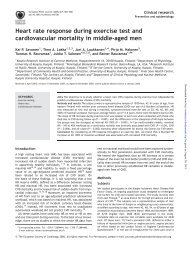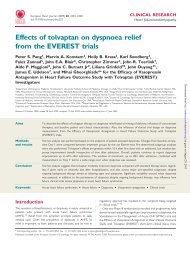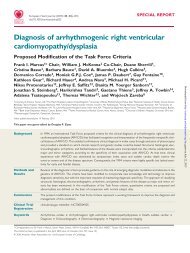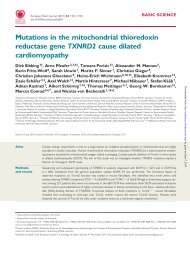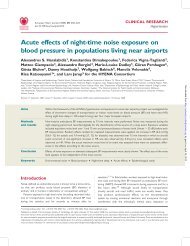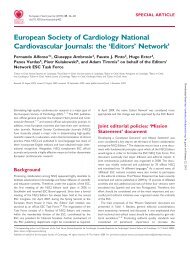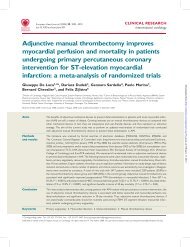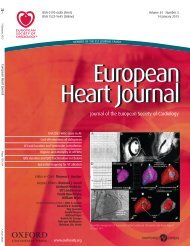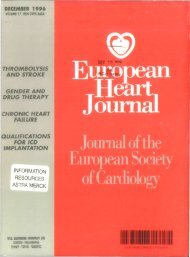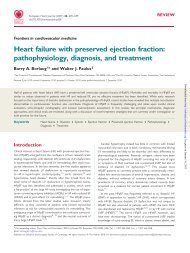Monday, 1 September 2008 - European Heart Journal
Monday, 1 September 2008 - European Heart Journal
Monday, 1 September 2008 - European Heart Journal
You also want an ePaper? Increase the reach of your titles
YUMPU automatically turns print PDFs into web optimized ePapers that Google loves.
284 Optimisation of techniques and adjunct therapy in cardiac surgery<br />
dure. Demographic profiles, operative data, long term survival and quality of life<br />
by the Short Form 36 Health Survey questionnaire were analysed.<br />
The 30 day mortality was 14.7% in the reoperation group and 8.5% (p=0.43)<br />
in the control group. Average time between previous operation and reoperation<br />
was 10.8±5.6 (range 1.7–30.6 years). Actuarial survival at 1, 3 and 6<br />
years was 77.2±5%, 58.3±6.3% and 36.3±7.8% for patients with reoperation<br />
and 71±5.5%, 58.3±6.3% and 30±8.1% for matched patients with primary cardiac<br />
surgery (p=0.68) (figure). No significant differences regarding the physical<br />
(40.7±9.4 vs. 39.1±10, p=0.55) and the mental health summarized-score<br />
(51.9±10.9 vs. 48±12.9, p=0.24) of the SF-36 were found between groups.<br />
Octogenarians exhibit a similar mortality, long-term survival and quality of life following<br />
primary and redo cardiac surgery. Therefore, this kind of surgery should<br />
not be reserved for younger patients alone.<br />
P1885 Mass-III: a randomized study comparing on-pump and<br />
off-pump coronary artery bypass graft surgery: 3-year<br />
results<br />
N.H. Lopes1 , A.F.T. Gois2 ,F.S.Paulitsch2 , C.L. Garzillo2 ,L.Dallan2 ,<br />
L.A.M. Cesar2 , N.A.G. Stolf2 , W. Hueb2 on behalf of MASS. 1<strong>Heart</strong> Institute - INCOR, Chronic Coronary Disease Department, Sao Paulo, Brazil;<br />
2<strong>Heart</strong> Institute, Sao Paulo, Brazil<br />
Introduction: In recent decades, concern has been increasing regarding reducing<br />
mortality and morbidity related to coronary artery bypass graft (CABG)<br />
surgery, particularly related to on-pump procedures. In this scenario, the development<br />
of off-pump techniques might provide advantages.<br />
Objectives: We compared the results of on-pump and off-pump procedures, regarding<br />
data during surgery, clinical evolution after surgery, and mortality and<br />
morbidity at 3-year follow-up.<br />
Methods: Patients with multivessel chronic coronary artery disease (CAD) and<br />
preserved left ventricular function who needed a CABG procedure and were suitable,<br />
according to surgeon’s assessment, for either on-pump or off-pump revascularization<br />
techniques were randomized and followed up. The duration of the<br />
surgery and need of a ventilator, intensive care unit (ICU) and hospital stay, clinical<br />
problems, and need of a blood transfusion were analyzed. The primary endpoints<br />
were cardiac death, myocardial infarction, and refractory angina requiring<br />
a new intervention.<br />
Results: 279 patients were randomized: 140 to on-pump and 139 to off-pump<br />
CABG. Baseline profiles were similar between the groups. Of those in the offpump<br />
group, a significant reduction occurred in the duration of surgery (4,08h vs.<br />
5,04h, p



